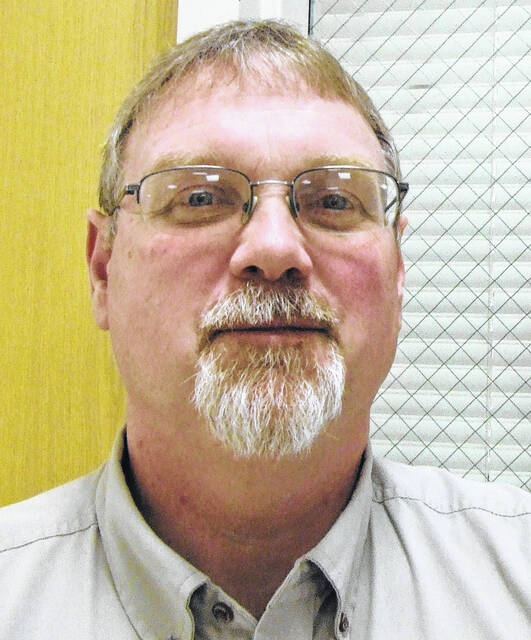
This week I’ve been participating at the Ohio State Fair.
There are two things that pop into my mind each day I’m driving back and forth to Columbus. The first is for all inquiring minds like me, “Why is there as much as a 70-cent difference in gas prices between her and there?”
I found gas for $3.53/gallon near Columbus.
The second thought I have pondered this week is the how variable crops look from county to county, field to field. It does not matter where I have been, the weather has certainly impacted crop production for 2022.
As the old saying goes, “You can’t change the weather.” But, you can do yourself some good as a producer by understanding crop growth and scouting for any issues before they become a big problem.
Currently, many soybean fields in Ohio are at the R3 growth stage, meaning there is a pod at least 3/16 inch long (but less than 3/4 inch long) at one of the four uppermost nodes on the main stem with a fully developed leaf.
Some late planted fields may still be at the flowering growth stage while some early planted fields may be entering the R4 growth stage (pod 3/4 inch long at one of the four uppermost nodes on the main stem with a fully developed leaf).
OSU agronomist Dr. Laura Lindsey addresses the question, “What does the soybean crop need to maximize yield during pod set?”
The number of pods per acre sets the maximum number of seeds per acre, which is the component most strongly related to final yield. Therefore, pod development becomes one of the most critical stages in the life of soybean.
While stress at this time will result in aborted pods, seed number per pod and seed size may compensate for loss of pods. T
he R3-R4 growth stage is an important time to scout your fields for diseases, insects, and nutrient deficiencies and apply fungicide, insecticide, and foliar fertilizer if conditions warrant an application.
There are several common misconceptions about soybean plants at the pod set stages. Dr Lindsey acknowledges the misconceptions and gives us the “reality” response.
Misconception — The soybean plant needs to retain most of its pods to maximize yield.
Reality – Pod abortion occurs naturally and allows the soybean plant to adapt to current environmental conditions. Many pods will still abort under stress-free conditions.
Misconception — Presence of 4 and 5 bean pods is required for high yields.
Reality — Pod number and seed size affect yield more than seeds per pod.
Misconception — Light needs to penetrate the whole canopy.
Reality — Complete canopy closure by this stage is important to capture all available sunlight, retain soil moisture, and reduce weed competition.
Misconception — Making a sprayer trip across the field will either be beneficial or neutral.
Reality – Tire traffic at this stage can lead to yield declines.
Misconception — Foliar fertilizers will be beneficial to provide nutrients to pods and will impact yield.
Reality — Data from across the U.S., shows no yield benefit to foliar fertilizer application at the R3 in the absence of a visual nutrient deficiency.
Misconception — Late season nitrogen application will provide a positive return on investment.
Reality — Data from across the U.S., shows no consistent economic benefit to late-season nitrogen fertilizer application.
For more information on soybean pod set, see this Science for Success video: https://www.youtube.com/watch?v=ThlgsQ4lOiQ and also this Science for Success FactSheet: https://bit.ly/3cK2yBs.
Scout for issues
Now that we are deep into crop progress for the growing season, now is the time to get out into the fields and scout for issues, this includes insect defoliation.
According to Ohio State entomologists, Kelley Tilmon and Andy Michel, in soybean, while the defoliation damage from various species might look startling, it is rather rare that this reaches economic levels.
Soybeans are master compensators. OSU agronomist Dr. Laura Lindsey reports that she has even weed-whacked large portions of soybean foliage and seen no difference in yield by the end of the season!
For defoliating insects in soybean, we usually use an overall defoliation measure as the threshold, regardless of what species is doing the feeding. This helps account for situations where more than one species may be having its bite.
Entomologists have recently calculated new thresholds for soybean defoliation based on more modern crop values and input costs. A rescue treatment is advised when defoliation levels reach 30% in pre-bloom stages, 10% during pod development and fill, and 15% at R6 (full seed).
After R6, a spray will not pay. These defoliation levels apply to the plant as a whole, not just certain leaves. Damage is often worst at the top of the canopy but on closer examination most of the plant is relatively unharmed.
Make your decision based on the average condition of whole plants, not a scan of the top canopy.
Also, defoliation tends to be worse on field edges, so make your assessment based on the field as a whole, including interior.
A visual guide to defoliation is useful because it is very easy to over-estimate defoliation in soybean. For more information, visit our new Soybean Defoliation scouting card at: https://aginsects.osu.edu/sites/aginsects/files/imce/Soybean%20defoliation%20Final.pdf.
Tony Nye is the state coordinator for the Ohio State University Extension Small Farm Program and has been an OSU Extension Educator for agriculture and natural resources for over 30 years, currently serving Clinton County and the Miami Valley EERA.


